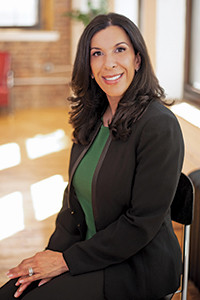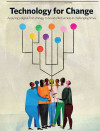 (Illustration by iStock/z_wei)
(Illustration by iStock/z_wei)

When Tanya Ramos took the helm of Pencils of Promise (PoP) two years ago, she was already a lifelong evangelist for the brand. As the first college graduate in her family, Ramos saw the nonprofit’s mission of leveling the playing field to make education available for all as a natural fit for her career. In this interview with Salesforce.org Global Head of Communications Devi Thomas, Ramos talks about the importance of being an early adopter and how her visionary leadership has brought data to the center of her organization’s work.
 Tanya Ramos
Tanya Ramos
Technology for Change

Nonprofits need digital technology to meet today’s pressing challenges and serve their communities. This collection of articles explores the ways in which the social sector can and already is applying a digital-first strategy to boost its effectiveness. Sponsored by Salesforce
-
Grecian Urns and Trend Reports
-
Invading the Darkness of Child Sex Trafficking
-
From Measurement to Success
-
Technology Is Her Compass and Data Is Her Guide
-
Tech and Data That Inform, Inspire, and Involve
-
Data-Driven Connections for a Better World
-
Being a Digital-First Leader
-
Creating a Digital-First Strategy
-
Driving Social Change With Data
Devi Thomas: How did you get started at Pencils of Promise and what led you to this cause?
Tanya Ramos: Most of my work was domestically focused and related to education. When this opportunity presented itself, it offered such a great marriage of everything I had done over my career. I’m a Latina, first-generation college graduate, so my career has really been about ensuring that children who look like me would have the same opportunities. That came in the way of college access and having the joy of being able to fundraise for missions that really resonated with me. It was very natural for me; my mantra has been that every child should have access to a quality education, regardless of what zip code they are in, and that was what my work was domestically focused on. Now, it doesn’t matter what country they are born into or what circumstances they are born into. Every child should be able to leave school literate and be able to change their life trajectory, and PoP has enabled me to make that happen.
DT: Tell me a bit about how the organization looked when you took over. What were some of the biggest challenges that you identified?
TR: PoP has always been an innovative and data-focused organization. An organization that is data driven and has leveraged that data to make informed decisions around our program delivery and our school builds.
That is indeed what it looked like when I arrived.
The biggest challenge I faced at the time of my appointment was change management. I was a new leader coming into the organization after more than three CEO shifts in four years. As with any leadership change, there were staff transitions as well, which contributed to talent gaps—which is not easy to navigate during leadership change. This, coupled with some teams working in silos, contributed to communication challenges that needed to be addressed.
DT: What was your relationship with technology before you took this job?
TR: Because I work in fundraising and managing relationships, technology in any form was always part of my being effective, efficient, and innovative. So I was always an early adopter and I gravitate toward tech to be effective and fundraise for the causes I care about.
Ironically enough, I met your CEO, Marc Benioff, more than a decade ago when I was working with the Taproot Foundation. The organization was using Salesforce and it was an amazing platform. We were collaborating with The Warner Foundation, and we gave Mr. Benioff the innovation award at one of our first events.
DT: How and why did PoP become an early adopter of digital tools?
TR: Our founder, Adam Braun, was always very forward-thinking and he came from the for-profit realm, where they had resources at their fingertips. His vision for PoP was to create a for-purpose organization that would ensure education for all and did not forgo the many innovations and technologies that for-profit companies use—we just had to find the ones that work best given the constraints of our resources. That being said, he was one of the first adopters of Salesforce because he wanted to find an equivalent to what he used at Bain & Company.
All of the team members who started with Adam, many of whom were early on in their own career trajectories, signed on and adopted quickly because they saw the value. In subsequent years, any other team member who was brought into PoP knew that Salesforce was the CRM [customer relationship management] that we use. They knew how we leveraged it and I would say it was very much a part of the fabric.
PoP is a leader in the application of technology. One thing I’m always able to point to that’s reassuring is that PoP has always relied on Salesforce throughout the organization’s history, not only as a robust system for managing strategic partnerships but also as a way to live-track our impact in the countries that we operate, which are primarily Guatemala, Laos, and Ghana.
So, let me unpack what that looks like, starting with the impact side of the house. Salesforce gives us real-time updates that alert us to when a school breaks ground in one of the countries where we operate. And when a student literacy test is conducted, or when a water, sanitation, and hygiene (WASH) workshop is completed, we get instantaneous feedback that allows us to make timely, programmatic decisions and tell a transparent story about our impact. That has remained true from our inception to this very moment. It’s been really reassuring that the impact team has stayed focused on ensuring that Salesforce is up to date.
I can’t do my job unless I am able to get weekly updates and review where we are relative to our goals and where we need to be. When major donors are on my calendar, I need to be able to quickly see donation and communication history. Those were the things I was always accustomed to having and I certainly had initially when I came to POP. As you can imagine, we are dependent on that as a field team and a global team.
DT: What challenges have you faced internally in making the case for change with those who are hesitant to adopt new tech?
TR: When we transitioned to newer hires, we saw some challenges with adoption of our platform on the fundraising side. This, of course, outside of impact is the second most important thing we do because it keeps the lights on and enables us to have the impact that we intend to have. So, that is where it was most challenging because we continued to have all the real-time data that we needed around impact, but the fundraising updates were lagging behind because many of the new team members were not leveraging it to the degree that they needed to. So, that was something we needed to address ASAP.
And I would say with the newer team, the biggest challenge was that we needed to change user behavior. Anyone who knows a CRM platform knows that the system only functions if everyone is tracking with it correctly.
Folks at PoP were accustomed to leveraging technology well before I came on board. In the past eight months of my tenure, we have been helping our new leaders learn Salesforce because some of them weren’t using it in their previous jobs. And I think new team members were feeling overwhelmed with trying to get up to speed with being clear about their respective goals and the overarching goals of the organization, and simultaneously trying to learn a platform. We always articulated that keeping on top of Salesforce was important and something that we needed to maintain for us to have a dashboard and stay on track with our goals.
DT: What were some of the tools you used to get your new team on board with that digital-first mindset?
TR: Well, just to be clear, it’s ongoing. But at the end of the day, I know it starts with leadership and that as CEO, I need to invest in maintaining our core value of innovation and expanding our solutions. I believe I have a responsibility to advance our technology footprint.
We recognize that a big part of being successful is leveraging our CRM the best we can. We ended up hiring a consultant who was an expert in Salesforce, and this resource partnered with our in-house Salesforce guru. Cloud for Good worked with the team to clean up the majority of our records and supported our guiding principles and plans to get where we need to. That was a game changer. Many of our team members were new and this expertise was needed while they were given the space and grace, as I call it, to get up to speed. Then we had socializing meetings, getting the team accustomed to hearing the terms around Salesforce and getting them to have some “skin in the game” in updating their respective records or asking them to create dashboards for the portfolio of relationships they were managing.
I’m happy to report that, now, with nearly eight months under their belt, they’re making sure that Salesforce is up to date and that we’re leveraging it in the way that we have always done over the last decade, and it’s feeling like we’re certainly on the right track. We’re not unique in this experience. And we’re very much aware that as we continue to grow, more and more focus needs to be placed on training and support.
DT: Tell me some outcomes you’re starting to see because of it. It’s a mental shift in some ways, isn’t it?
TR: That’s exactly right. Overall, part of our secret sauce at PoP is how focused we are on data. It’s really enabled us to distinguish ourselves from our peers. We have a powerful brand identity relative to our use of digital and social media, while other organizations have had to adapt to accommodate a digital landscape. PoP has organically, and I want to say almost seamlessly, embraced and owned that space.
DT: So, are you saying that unifying and leveraging your data has had repercussions for your nonprofit brand?
TR: I could not agree more that we have future-proofed our brand by creating more transparency and visibility through data. I will say that for our size, we’ve really developed a brand that’s highly recognized and we punch well above our weight. There’s no doubt that Salesforce has really contributed to that.
DT: What’s next for you in terms of digital innovation?
TR: Innovation is a team effort here and it has to start from the top. Our senior leadership has to model digital behavior for it to have legs. We’ve also managed to ensure that there are leaders on every team who prioritize Salesforce in every country we work in. In fact, 100 percent of the data we collect globally is collected digitally. That speaks volumes to the commitment of our teams.
When we take visitors to our schools in Ghana, they see teacher interventions being entered and reported on in our Salesforce reports. Every PoP team member learns how to review data in their digital forms and then source them to Tableau dashboards—this is how we all tell our story with numbers.
We will continue to use digital technology to maximize our efficiency and transparency and to meet stakeholders where they are. For example, we are actually set up to receive donations no matter how they come in. When we got our first donation in cryptocurrency in 2017, we thought, “How can this best serve our students?” We adjusted our flexible digital platform to allow a $1 million donation in cryptocurrency—that’s how cutting-edge PoP is today and we will continue to break new barriers in this way.
Our programs have just continued to mature and become better because of our data and our tech-friendly DNA. Donors see that and love it. For us, all that data creates limitless value.
Support SSIR’s coverage of cross-sector solutions to global challenges.
Help us further the reach of innovative ideas. Donate today.
Read more stories by Devi Thomas.

